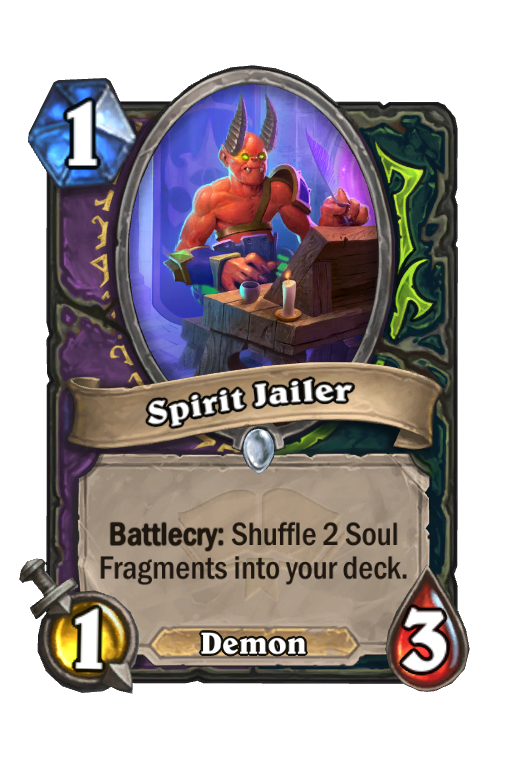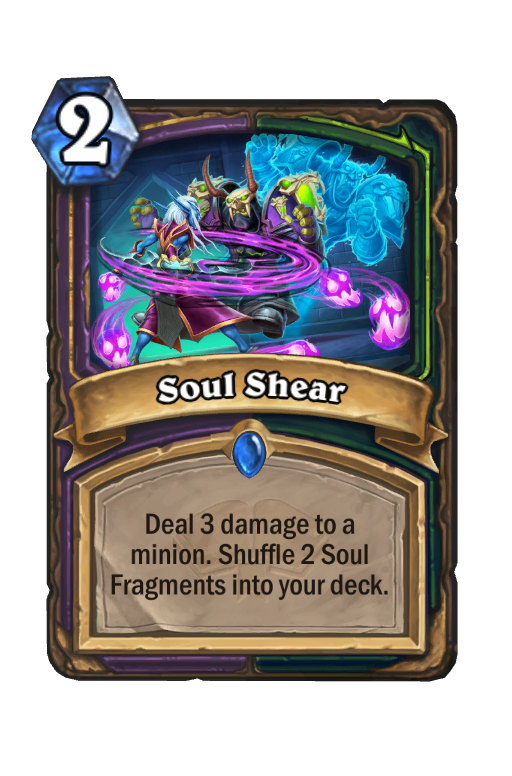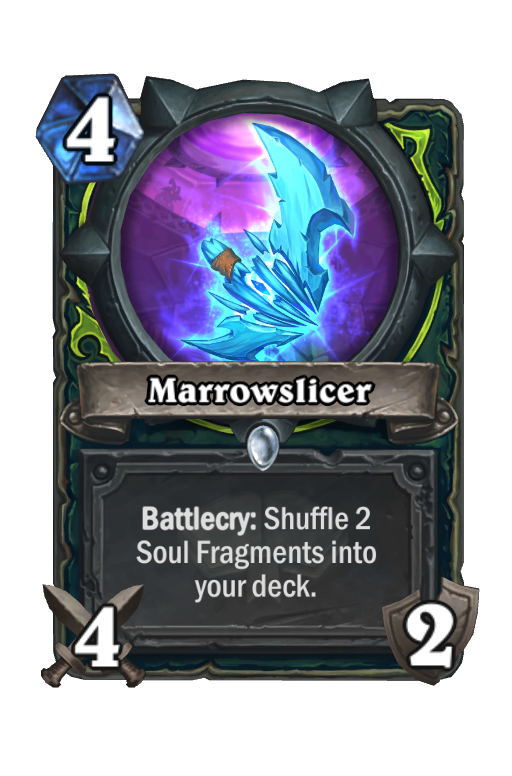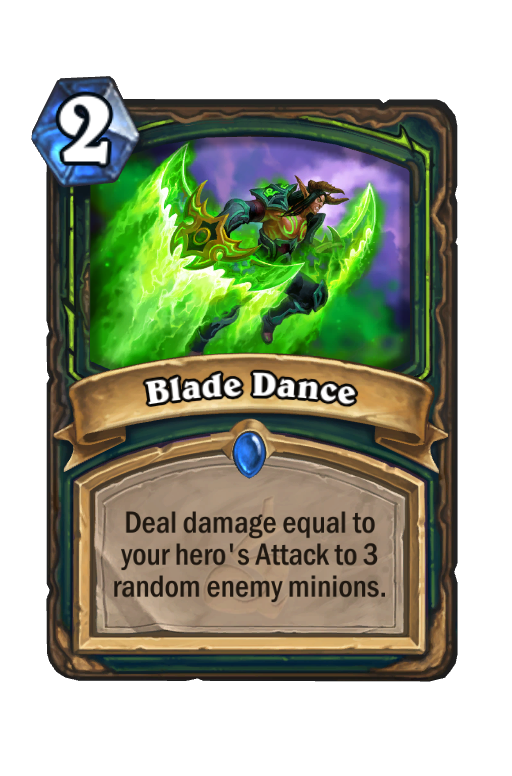
As the Scholomance Academy meta has begun to settle (ever so slightly), one archetype has moved to the top of the list for fun and effectiveness: Soul Demon Hunter. This new archetype uses Soul Shard synergies to control the board and build up to massive swing turns that are difficult for most other decks to keep up with.
Over the course of the August season, I walked the deck through over 300 games, 4 different major iterations, and then 8 small tweaks to the final iteration (which dropped Magtheridon) -- testing removing/adding the following:
Eye Beam, Magtheridon, Consume Magic, Polkelt, Wandmaker, Vulpera, Immolation Aura, Spectral Sight, Panthara, Shadoweaver, Battlefiend, Glaivebound, and Sneaky Delinquent.
These tweaks were indicative of a really enjoyable component of the deck: how many cards can move in and out to bring about a new, fresh experience/analysis of the archetype.
On the Asia Server in the last week of August, I held a 65% win rate over 87 games to climb from Legend 6900 to 1200, including favorable winrates against everything except for Demon Hunter. The list I settled on was 42-18 over this stretch (70%) and felt extremely strong and consistent when I played correctly. It was at this point that I was excited to do a write up and share both my enthusiasm and hopefully a few tips that will help others enjoy the deck as well.
### Ignatius Soul DH # Class: Demon Hunter # Format: Standard # Year of the Phoenix # # 1x (1) Consume Magic # 2x (1) Spirit Jailer # 2x (1) Twin Slice # 2x (2) Blade Dance # 2x (2) Chaos Strike # 1x (2) Immolation Aura # 2x (2) Manafeeder Panthara # 2x (2) Soul Shear # 1x (2) Spectral Sight # 2x (2) Wandmaker # 2x (3) Aldrachi Warblades # 2x (3) Shardshatter Mystic # 1x (4) Kayn Sunfury # 1x (4) Lorekeeper Polkelt # 2x (4) Marrowslicer # 2x (5) Soulshard Lapidary # 2x (6) Skull of Gul'dan # 1x (7) Soulciologist Malicia # AAECAea5AwbaxgPUyAPVyAPP0gPd0wP21gMMh7oD17sD4LwD2cYD/MgD0c0D+84D/tEDzNIDzdID1NID99UDAA== # # To use this deck, copy it to your clipboard and create a new deck in Hearthstone
View this deck on HSReplay.net
Explaining This List
The aspects of this list that I think are unique to others that have been successful are:
No Vulpera Scoundrel, Eye Beam, or Magtheridon.
Yes Immolation and Wandmaker.
It may also be worth mentioning (as I know it has been a point of discussion) that Polkelt is outstanding. I should also concede that Glaivebound appears to be a really successful card in the deck. I just did not find out how it fit the greater whole as much as other cards in my own playing.
At this point I think we have enough stats in HSReplay.net where broader discussion is not essential, but as the deck still has a lot of iterations, it is worthwhile -- at the very least -- to explore the why’s of the stats that are available:
Vulpera and Eye Beam: these two are documented over 17,000 top 1000 legend games as two of the worst cards (drawn winrate). I also felt that they were really poor in the first 50 games or so.
Magtheridon: just behind them is Magtheridon, but I think Magtheridon begs for a bit of discussion, because drawn winrate for cards like Mag (and Polkelt) can be a correlation/causation trap. That said, in my first 80 or so games with the deck, Mag just felt way more wrong than right. And, while Mag is strong against Druid, Mag is also a ridiculous liability against Priest (they steal it, and you can’t deal with it). I started to see way more Priest than Druid, and the swap felt great. By far my most successful list came as I dropped Magtheridon. Thought, I still wonder if I just use the card poorly because other players who are better than me insist it should stay.
Wandmaker and Panthara: these cards are just good. The 1-cost spell pool got a bit of a soft nerf, but even Double Jump and Felosophy found their moments, while Slice, Burn, and Consume were outstanding. Also, Wandmaker’s generation is an improvement over Vulpera almost always because your curve gets clunky with Vulp (1 turn later, and cards that cost more than 1).
Consume Magic: 1 copy of this card just seems great to me. When are you sad to spend 1 and draw 1 with this deck where you are almost always ahead or able to clear whatever is in front? Without Outcast, you can silence great targets vs Priest and Druid, late taunts as you’re racing a slower Rogue. This deck’s ability to draw means that you can actually find this card consistently in the matchups where it’s essential -- I also hit it many times off the DJ from Wandmaker. If all this wasn’t enough, I found several games where I was really comfortable with a tempo Kayn Sunfury because I had Consume as a 1-mana backup to get through a taunt. Comfortable tempo Kayn is scary.
The Mulligan



There are a few matchups where particularities in the mulligan make a world of difference. If you are just getting started, you can’t go too wrong keeping (in order):
- Spirit Jailer
- Wandmaker
- Aldrachi Warblades (vs. aggro)
- Panthara
- Chaos Strike
- Soul Shear
- Shardshatter Mystic (if you have Jailer/Shear in the right matchup)
- In slower matchups, if Skull or Spectral can be slotted into the left Outcast slot, keep it
I’ll provide specific mulligan priorities per class below. PLEASE look at these, as the winrates I had vs the 3 most common classes were largely because of mulligan choices (100% v mage, 86% v priest, and 75% v rogue)
Matchups
I’m going to provide in-depth tips against the 3 most common classes I faced: Rogue, Mage, and Priest. This is in part because these are also the 3 where technique can make you significantly favored.
vs. Rogue
Quick Mulligan: 1. Immolation 2. Blade Dance 3. Jailer 4. Aldrachi
One huge advantage of this deck vs rogue is that it does not matter which rogue it is. You mostly play the same. I look HARD in the mulligan for cards that remove their early stealth minions -- Immolation Aura and Blade Dance. If you have a Soul development (Jailer, Shear), then you can keep Shardshatter Mystic as well. The only card I will keep that is not these cards is Aldrachi Warblades.
Kill the early stealth minions. If you feel they are planning to play Greyheart Sage, don’t worry about the value of your AOE. Just get Spymistress off the board. It’s strange, but turn 2, 3, and 4 being Immolation, 1-damage Blade Dance, and then Shardshatter feels wrong, but you’ve probably won the game with that opening.
Get significant heal off of Aldrachi. A nice trick is to swing and then equip it, so you are removing something without using a charge, because you want to buff it up for big heals on later swings.
If you got out of turn 6 with 18+ health, you are probably on a winning path. Recognize as well that Rogue doesn’t answer Soulciologist Malicia efficiently. If you can plan to run her onto a board and go up-tempo, it’s another easy win.
Looking at my 4 losses over 16 games vs. rogue, in all 4 I did not find the early AOE. I recall in two of these games not digging hard enough for it (keeping Wandmaker / Panthara), and deeply regretting it when I lost.
vs. Mage
Quick Mulligan: 1. Sheer, Slice, or Chaos 2. Jailer 3. Wandmaker 4. Panthara 5. Aldrachi
If I were to lose to a mage, something went unbelievably wrong in RNG (i.e. Puzzle Box), or I misplayed. Mage was 100% a winning matchup for me when I got the hang of the deck, and each game felt like a blowout. However, there were some subtle things I did wrong in early games with the deck.
In the mulligan, prioritizing removal for Lab Partner is significant. The turn-1 partner into Cram Session is extremely powerful, but if you clear it with Shear, Chaos, or Twin Slice, you will be good to go. A good Mage will realize the unfavorability of the matchup, so Tempo Chenvaala, Firebrand, and early Apprentice should be anticipated.
Throughout the game, one thing you need to manage thoughtfully is when to put Souls into your deck. Just because you have a Spirit Jailer and 1 mana left, or you have a usable Soul Shear, it does not necessarily mean you should use it. Early games I lost were often because I shoved Souls in because I could, and it took awhile to finish the mage, and my synergies were exhausted in later turns from drawing Souls uselessly. Your health total is not a commonly valuable essential resource in this matchup, so the passive soul draw is REALLY bad.
In the late game, keep an eye out for face-freeze cards from the mage, and where you have an option to deal slightly more damage to the face before mage finds Frostbolt off Evocation or Mana Cyclone, or worse, finds Deep Freeze, the better. Another late game tip is to hang onto a Blade Dance for the possible giants, which could be dumped out to try and race you to death.
vs. Priest
Quick Mulligan: 1. Sheer, Slice, or Chaos 2. Wandmaker 3. Panthara 4. Keep Skull or Spectral in Outcast slot
Priest turned out to be one of my favorite matchups, because though it is favored, it is very easy to goof up and make it feel not favored. (I did not start feeling that it was significantly favored until I removed Magtheridon & Eye Beam, and added Consume Magic).
If I have a removal for early Sethekk Veilweaver in the mulligan, I will look hard for the 2-drops and try to prioritize getting a Skull onto the far-left side of my hand. I do NOT keep Jailer in mull vs. Priest.
There are two ways I could subtly screw up in this matchup: shoving Souls into my deck early, and not prioritizing every point of damage that comes from my face to the Priest's face. It’s hard to explain, but one significant tip is that you don’t want to start “caring” about damaging the face until you are starting to snowball your damage past their healing, and until you have a line of sight to getting near the bottom of your deck. For this reason, you want to TRADE with your early minions (not hit face). I will often just let one minion sit on the board, so that the priest cannot use a single card to clear two minions. And most importantly, if I’m using Aldrachi, Marrow, Soulshard, Chaos, or Twin Slices to remove minions, I know I’m having to play inefficiently.
Another thing to mention is the value of baiting an early Apotheosis. Getting the Priest to 22-24 with minions, and letting Apotheosis come out so they go back to 28-30 is not bad if you haven’t used your weapon/face damage yet. There’s enough in your deck to obliterate them if you save it and send an avalanche over 4 turns in the late game.
I can’t say enough how bad it is to put Souls in early against Priest (like with mage, but moreover). Many victories came down to the bottom of my deck, and running out of Souls, or not having one available down the homestretch is devastating. Likewise, passively drawing them is almost always bad against Priest.



Soul Demon Hunter is delightfully symptomatic of how good the state of the game is right now. It is dynamic, high-skill, extremely powerful, and has different techniques for each matchup that improve its capacity to succeed. It also just breaks the game sometimes (1-mana Marrowslicer, 2-mana Lapidary, 2-mana Twin Slices, Blade Dance for clear, and punch the face for 14 while playing a 5/5 … all of this in a calculated setup with Polkelt, are you kidding me!?) I just can’t get enough!

Thanks again to Ignatius for sharing his thoughts on Soul Demon Hunter with us! You can find his content through the links below.
- Twitter: https://twitter.com/IgnatiusHS
- Twitch: https://www.twitch.tv/ignatiushs
Subscribe to Premium or Tier7 to access our full breadth of Standard and Battlegrounds data, including advanced filters, mulligan guides, personal statistics and much more.
Follow us on Twitter, Facebook and Instagram for daily Hearthstone stats and news.
